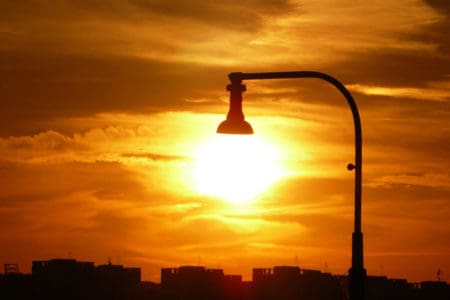What does the efficiency, efficacy and luminous efficacy of LED lamps stand for? Here you can find out the exact meaning of the individual terms. You can also find out what efficiency current LED lamps already achieve. The comparison with the old light sources shows you how much better LED lights perform.
LED Efficiency and Efficacy
The efficiency and efficacy of LED lamps are often mixed. This is certainly due to the fact that there is a direct connection between these two terms. Before further consideration, you should familiarize yourself with the exact definition.
The efficiency of an LED indicates the ratio between the electrical power consumption and the luminous flux emitted in lumen.
The efficacy of an LED is the luminous efficacy. This is expressed in lumens per watt (lm/W).
The efficiency is a ratio between the two quantities mentioned and is therefore given as a percentage value. In order to determine the efficiency of an LED illuminant, the power consumption and the emitted luminous flux must be measured. But what maximum luminous flux would be possible and would mean an efficiency of 100%?
To do this, you have to take a look at the world of physics. According to this, the theoretical maximum for the luminous efficacy is approx. 350 lm/W for cold-white LED’s. An LED lamp with a power consumption of 1 watt and a luminous flux of 350 lumen would have an efficiency of 100%. However, in practice such LED lamps are a dream to come true 🙂
The real efficiency of current LED light sources is about 30% to 40%. Apart from that, an efficiency of 100% would not be possible in practice anyway, as there are numerous components in an LED lamp where losses occur.
What efficiency is possible?
In order to achieve the highest possible efficiency for the LED luminaire or illuminant, efficient light-emitting diodes must be installed. For example, the high-power LED319A from Nichia achieves an astonishing luminous efficacy of 164 lm/W. This gives it an efficiency of just under 47%. This is the current record in series production.
But this is only the efficiency of the light emitting diode. An LED lamp also contains an LED driver and optical components. These also have an efficiency, so that the overall efficiency is lower again. Current LED lamps have an efficiency of about 30% to 40%. The remaining energy used is radiated as heat.
The overall efficiency of an LED lamp includes all the components it contains. This is often referred to as wall-plug efficiency.
The temperature of the LED has another often underestimated influence on the efficiency. The lower the operating temperature of the LED, the better its efficacy and thus its efficiency. Good thermal management within the light source to dissipate the waste heat from the LED to the environment would be an advantage.
Where do the losses occur?
An LED lamp contains various components where losses can occur. In most cases these are the following components:
- Driver electronics
- Light emitting diode(s)
- Optics
The driver electronics or power supply unit converts the 110V mains voltage into the operating voltage required for the LED. These electronic circuits are constructed differently depending on the manufacturer and have efficiencies of 70 to 90%.
The LED’s installed in the light source have the greatest influence on the overall efficiency. The decisive factor here is how much light can be decoupled from the semiconductor into the environment. Commercially available warm-white LED luminaires are usually equipped with light-emitting diodes with an efficiency of around 25 to 35%.
The optics (lenses, color filters, etc.) within an LED light source also have an influence on the overall efficiency. For example, special diffusing lenses are used to achieve a certain beam angle of the lamp. However, the efficiency of the optics is very good compared to that of LED’s itself.
Calculate LED Efficiency
The overall efficiency of an LED lamp is calculated by multiplying the individual efficiencies of all the components it contains.
LED driver (90%) · LED (35%) · optics (95%) = 30% efficiency
Calculation: 0.9 · 0.35 · 0.95 = 0.3 → 30%
Do you want to calculate the efficiency of an LED light from a shop? Set the luminous efficacy (lumens per watt) in relation to the physically possible maximum (350 lm/W) for cold-white LEDs.
LED illuminant delivers 1500 lumen at a power consumption of 13 watts
1500 Lumen : 13 Watt = 115,4→ Luminous efficacy 115,4 lm/W
Physical maximum (100% efficiency): 350 lm/W
115.4 lm/W : 350 lm/W = 0.33 → 33% Efficiency
Comparison of efficiency and luminous efficacy
LED lamps and luminaires are by far the most efficient light sources of our time. However, it needs some time before all old lighting technologies are completely converted to LED. If you are about to convert old light sources to LED, the following comparison of the efficiency of the various lighting technologies will help you. Basically, the efficiency is always slightly better at higher powers.
Efficiency of incandescent bulb
The efficiency of well-known incandescent lamps is just 5% of the used electrical energy. The remaining 95% are released into the environment as heat. This is why even incandescent lamps with low output and low brightness become very hot during operation. The luminous efficacy of an incandescent lamp is between 10 lm/W and 15 lm/W, depending on the power class.
Efficiency of halogen bulb
Halogen lights have an efficiency of about 10%. The remaining 90% are radiated as heat into the environment. The luminous efficacy of a halogen lamp is between 15 lm/W and 20 lm/W, depending on the power class. The efficiency is therefore only slightly better than that of an incandescent lamp.
Efficiency of energy-saving bulb
After all, the energy-saving lamp achieves an efficiency of up to 25%. Here only 75% of the electrical energy is converted into heat. The luminous efficacy is 40 lm/W to 60 lm/W. The efficiency compared to the incandescent lamp is at least a factor of four to five.
Efficiency comparison table
| Light Source | Efficiency | Luminous Efficiency |
|---|---|---|
| LED bulb | 25 – 40% | 80 – 150 lm/W |
| Energy-saving bulb | 15 – 25% | 40 – 60 lm/W |
| Halogen bulb | 8 – 12% | 15 – 20 lm/W |
| Incandescent bulb | 3 – 5% | 10 – 15 lm/W |
Conclusion
With an efficiency of 30% to 40% LED lamps belong to the most efficient light sources in today’s world. Now you know how to calculate the efficiency of an LED lamp before you buy it. So you can make sure to buy an efficient LED lamp with high luminous efficacy and not to catch a shopkeeper with a low efficiency.






